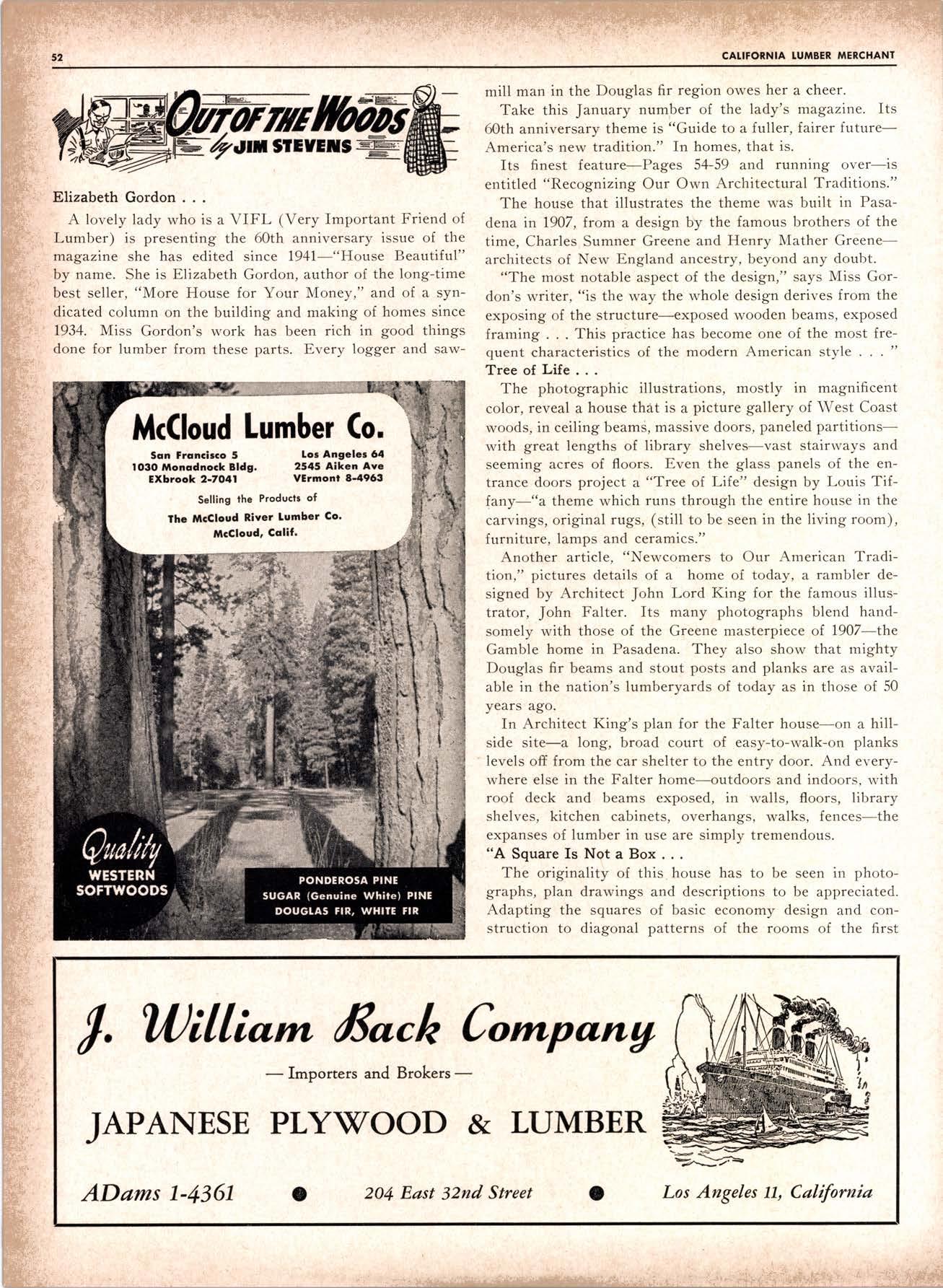
2 minute read
rooK uP
Hobbs Wall
lor the bcst in Redwood Dependoble deoling, courteoug service hove node Hobbs Wcll the oldest nome in lhe Redwood industry. Now-o3 lot 92 yeowdeolers everywhete count on Hobbs Wcll for the best in Redwood, grcde-wise, sizewise, price-wise. For pronpt service;tcll, wrife or wire us.
ElizabethGordon...
A lovely lady who is a VIFL (Very Important Friend of Lumber) is presenting the 60th anniversary issue of tl-re magazine she has edited since 1941-"House Beautiful" by name. She is Elizabeth Gordon, author of the long-time best seller, "More House for Your Money," and of a syndicated column on the building and making of homes since 1934. Miss Gordon's work has been rich in good things done for lumber from these parts. Every logger and saw-
Mc0oud Lumber Co,
mill man in the Douglas fir region owes her a cheer.
Take this January number of the lady's magazine. Its 6oth anniversary theme is "Guide to a fuller, fairer futureAmerica's new tradition." fn homes, that is.
Its finest feature-Pages 54-59 and running over-is entitled "Recognizing Our Own Architectural Traditions."
The house that illustrates the theme was built in Pasadena in 1907, ftom a design by the famous brothers of the time, Charles Sumner Greene and Henry Mather Greenearchitects of New England ancestry, beyond any doubt.
"The most notable aspect of the design," says Miss Gordon's writer, "is the way the rvhole design derives from the exposing of the structure-exposed wooden beams, exposed framing . This practice has become one of the most frequent characteristics of the modern American style " Tree of Life
The photographic illustrations, mostly in magnificent color, reveal a house that is a picture gallery of West Coast woods, in ceiling beams, massive doors, paneled partitionswith great lengths of library shelves-vast stairrvays and seeming acres of floors. Even the glass panels of the entrance doors project a "Tree o{ Life" design by Louis Tiffany-"u theme which runs through the entire house in the carvings, original rugs, (still to be seen in the living room), furniture, lamps and ceramics."
Another article. "Newcomers to Our American Tradition," pictures details of a home of today, a rambler designed by Architect John Lord King for the famous illustrator, John Falter. Its many photographs blend handsomely with those of the Greene masterpiece of 1907-the Gamble home in Pasadena. They also show that mighty Douglas fir beams and stout posts and planks are as available in the nation's lumberyards of today as in those of 50 years ago.

In Architect King's plan for the Falter house-on a hillside site-a long, broad court of easy-to-walk-on planks levels off from the car shelter to the entry door. And everywhere else in the Falter home-outdoors and indoors, with roof deck and beams exposed, in walls, floors, library shelves, kitchen cabinets, overhangs, walks, fences-the expanses of lumber in use are simply tremendous.
"A Square Is Not a Box
The originality of this house has to be seen in photographs, plan drawings and descriptions to be appreciated. Adapting the squares of basic economy design and construction to diagonal patterns of the rooms of the first










